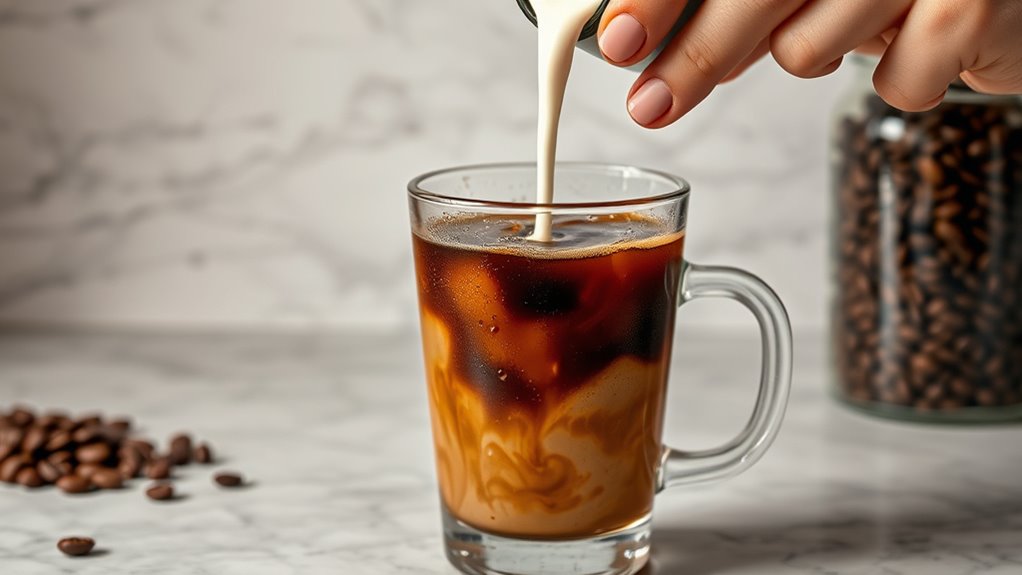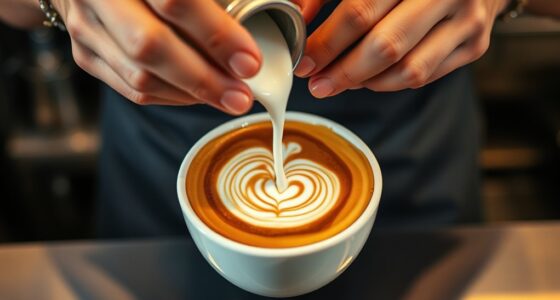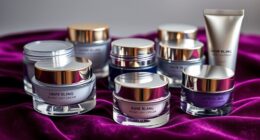Stop using fine coffee grounds, rushing steeping, or storing cold brew at room temperature. Instead, opt for coarse grounds, let it steep for 12-24 hours, and keep your brew refrigerated to guarantee safety and flavor. Add sugar during brewing, use filtered water, and clean your equipment regularly. Avoid over-filtering to preserve flavor, and warm your cold brew before drinking for a better taste. Keep going to reveal even more expert tips to perfect your cold brew game.
Key Takeaways
- Avoid using fine grounds; opt for coarse grind to prevent over-extraction and cloudiness.
- Don’t steep cold brew for too short a time; aim for 12-24 hours for optimal flavor.
- Never leave cold brew at room temperature over 12 hours; always refrigerate for safety and freshness.
- Refrain from reusing unclean containers; clean thoroughly to prevent off-flavors and mold growth.
- Skip over-filtering; choose quality beans and gentle filtering to preserve oils and flavor complexity.
Using Fine Coffee Grounds for Cold Brew
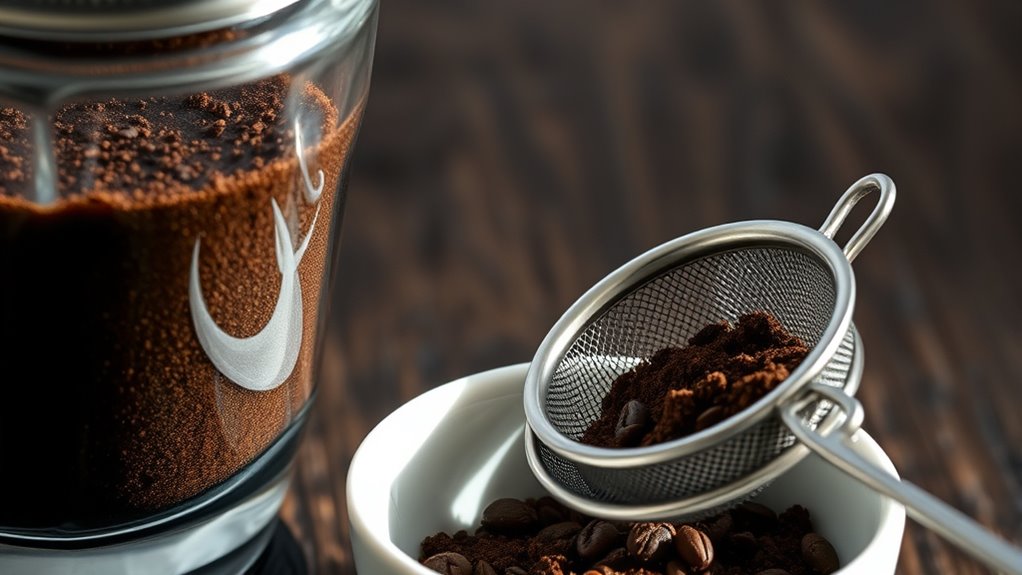
Using fine coffee grounds for cold brew can considerably impact the flavor and brewing process. When you choose a fine grind size, the extraction becomes quicker and more intense, which can lead to a richer, more robust coffee. However, it’s crucial to take into account coffee freshness—freshly ground beans release more vibrant flavors, enhancing your cold brew’s taste. Too fine a grind, though, can cause over-extraction and make your brew bitter or cloudy, so balance is key. If your coffee isn’t fresh, even a perfect grind size might not deliver ideal flavor. Always grind your beans just before brewing for the best results, and adjust the grind size according to your desired strength and clarity. Properly selecting grind size and maintaining coffee freshness ensures a smooth, flavorful cold brew. Additionally, using the correct filter type helps prevent over-extraction and improves the overall clarity of your brew.
Rushing the Steeping Process to Save Time

While it might be tempting to speed up the cold brew process by rushing the steeping stage, doing so can compromise the flavor and smoothness you’re aiming for. The key to a well-balanced cold brew is allowing enough steeping duration for proper flavor extraction. Shortening this time may result in a weak, underdeveloped taste, while rushing can lead to harsh or bitter notes. To get the best results, stick to recommended steeping durations—usually 12-24 hours. Here’s a quick comparison:
| Steeping Duration | Flavor Extraction |
|---|---|
| Short (few hours) | Weak, underdeveloped |
| Ideal (12-24 hrs) | Rich, smooth, balanced |
| Overly long | Bitter, overly strong |
| Rushed process | Incomplete flavor |
| Proper time | Perfect flavor profile |
Patience guarantees your cold brew hits all the right notes. Additionally, understanding the science behind flavor extraction can help you optimize your brewing technique for better results.
Storing Cold Brew at Room Temperature
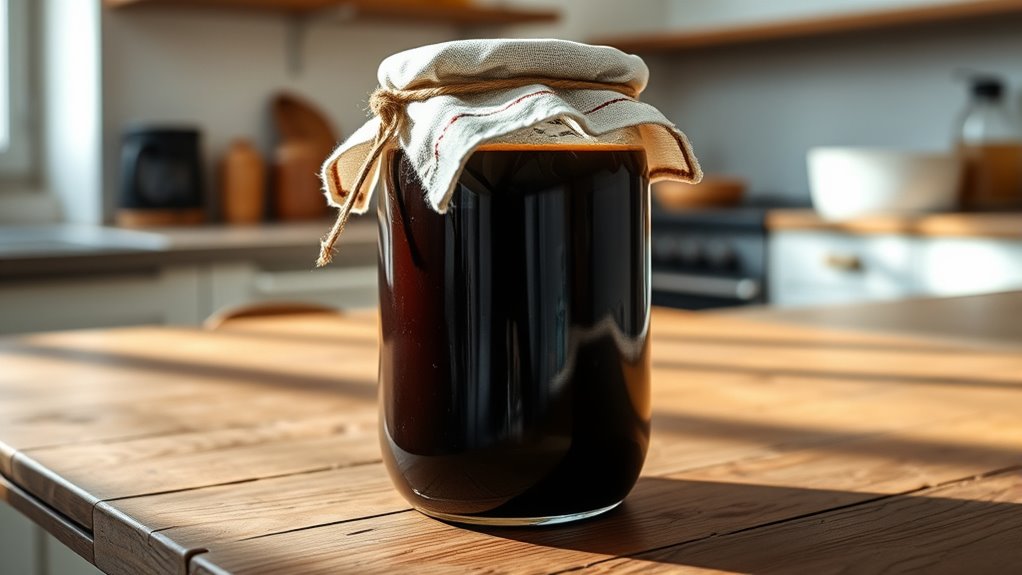
Storing cold brew at room temperature can be risky if kept too long, as bacteria can grow quickly. For the best flavor and safety, aim to keep it no more than 12 hours in a proper airtight container. Using a glass or plastic bottle with a tight seal helps preserve freshness and prevent spoilage. Additionally, proper storage techniques can significantly extend the freshness and safety of your cold brew.
Risks of Room Storage
Leaving cold brew at room temperature can lead to rapid spoilage and potential health risks. Ambient conditions, like heat and humidity, accelerate bacterial growth, making your coffee unsafe to drink. Unknowingly, you may consume sour, contaminated cold brew, risking stomach upset or food poisoning. To emphasize the dangers:
| Risk | What Happens | How It Affects You |
|---|---|---|
| Bacterial Growth | Spoils quickly in warm conditions | Leads to illness |
| Mold Formation | Develops on surface or inside | Causes allergies or infections |
| Flavor Loss | Becomes sour and unpleasant | Ruins your coffee experience |
| Health Risks | Potential food poisoning | Threatens your well-being |
Additionally, improper storage can diminish the freshness of your brew, reducing its flavor quality and enjoyment.
Ideal Storage Duration
How long can you keep cold brew at room temperature without risking spoilage? The ideal storage duration for cold brew at room temperature is limited. Typically, you should not leave it out for more than:
- 4 hours — if kept at a steady, cool room temperature, it’s still safe.
- Up to 12 hours — if kept in a shaded, cool spot, but it’s risky.
- Over 12 hours — avoid, as bacteria can grow quickly.
- Beyond 24 hours — spoilage becomes likely, and flavor degrades.
- Proper storage practices—such as using airtight containers—can help preserve cold brew longer and prevent contamination.
For the best quality and safety, it’s recommended to store cold brew in the fridge rather than at room temperature. This guarantees a longer, safer storage duration while maintaining its flavor.
Proper Container Choices
Choosing the right container is essential when storing cold brew at room temperature, as it impacts both safety and flavor. Look for containers with good insulation properties to help maintain the brew’s quality and prevent temperature fluctuations. Insulated containers keep the cold brew stable longer, reducing spoilage risk. Opt for BPA free options to avoid harmful chemicals leaching into your drink, especially when stored for extended periods. Clear containers allow you to monitor the brew’s freshness visually, but ensure they’re made from non-reactive materials. Avoid thin or fragile containers that may crack or break easily. A well-chosen container preserves flavor, ensures safety, and extends the freshness of your cold brew while avoiding unnecessary chemical exposure. Additionally, understanding color accuracy in projectors can help you select the best display for visual clarity and true-to-life images.
Adding Sugar During Brewing

Have you ever considered adding sugar directly to your coffee grounds before brewing? This method affects your sweetening options and sugar timing. Here’s what you should know:
- Enhanced sweetness – Adding sugar during brewing allows it to dissolve thoroughly, creating a sweeter, smoother cold brew.
- Flavor infusion – The sugar melds with coffee flavors, giving a balanced taste without extra stirring later.
- Control over sweetness – You can adjust sugar amount for your preferred level before brewing, avoiding over-sweetening.
- Consistency – This approach helps you achieve uniform sweetness every time, saving you from inconsistent results.
- Preserves nutrients – Using cold brew methods can retain more antioxidants and enzymes, enhancing health benefits. Cold-Pressed Vegetable Juice
Skip adding sugar after brewing; instead, incorporate it during the process for better control and flavor integration.
Using Tap Water Instead of Filtered Water

While tap water is readily available and convenient, it often contains minerals and impurities that can impact the flavor of your cold brew. Poor tap water quality may introduce off-flavors or cloudiness, diminishing your coffee experience. That’s why water filtration significance can’t be overstated—filtered water removes chlorine, sediments, and minerals that interfere with taste. Using unfiltered tap water can result in a flat or overly mineralized brew, masking the coffee’s true flavor. Investing in a good water filter ensures you get clean, fresh-tasting water every time. This simple step helps you optimize your cold brew’s flavor profile and enhances overall quality. Additionally, understanding the importance of vertical storage solutions can help keep your brewing space organized and free of clutter, making the process more efficient. Don’t underestimate the power of good water; it’s vital for brewing a smooth, balanced cold brew every single time.
Ignoring Proper Coffee-to-Water Ratios

When you ignore proper coffee-to-water ratios, your brew can become too weak or too bitter. Using precise measurements helps maintain consistent strength and flavor. Skipping this step can lead to over-extraction, making your cold brew less enjoyable. Incorporating data-driven strategies ensures you optimize your process for the best taste every time.
Precise Coffee Measurements
Focusing solely on precise coffee measurements without considering proper coffee-to-water ratios can lead to inconsistent and lackluster cold brew results. To get it right, pay attention to key details:
- Use a consistent measurement scale, like grams, for accuracy.
- Adjust the grind size to match your brewing method—coarse for cold brew.
- Monitor water temperature; typically, room temperature or cooler water works best.
- Keep measurements steady; even slight variations can affect flavor and strength.
Consistent Brew Strength
Achieving consistent brew strength in cold brew coffee depends on more than just measurement accuracy; it also requires controlling variables that affect extractability. To maintain brew strength consistency, pay attention to factors like steeping time, temperature, and agitation. Small adjustments can considerably influence the flavor profile stability, ensuring each batch tastes similar. Keep your steeping duration steady, as longer or shorter times alter the strength and flavor. Maintain a consistent temperature to prevent fluctuations in extraction rates. Gentle agitation during steeping can also help distribute flavors evenly. Additionally, using proper coffee-to-water ratios is crucial for consistent results. By managing these variables, you ensure your cold brew remains reliably strong and balanced, avoiding unexpected variations. This focus on stability creates a predictable, enjoyable flavor profile every time you brew.
Avoid Over-Extraction
Ignoring proper coffee-to-water ratios can lead to over-extraction, resulting in a bitter, harsh flavor in your cold brew. To prevent this, pay attention to your grind size and brew duration. Here’s what you should do:
- Use the right grind size—a coarse grind slows extraction, preventing bitterness.
- Adjust brew time—stay within 12-24 hours; longer times increase over-extraction.
- Measure accurately—stick to recommended coffee-to-water ratios for balanced flavor.
- Monitor your brew—taste periodically to detect over-extraction signs early.
Using the Same Jar for Multiple Brews

Using the same jar for multiple cold brew sessions can be convenient, but it’s important to understand how it might affect your brew’s flavor. Over time, residue from previous brews can impact taste, making equipment maintenance essential for flavor preservation. Regularly cleaning your jar prevents buildup of oils and coffee particles that can cause off-flavors. If you reuse the same jar without proper cleaning, you risk developing a stale or muddled taste. Also, using a clean, dedicated container helps maintain the freshness of each batch. Consider storing your cold brew in a separate, sanitized jar if you plan to make multiple brews. This simple step ensures your cold brew stays flavorful and prevents cross-contamination, ultimately preserving the quality of your coffee.
Over-Filtering Your Cold Brew
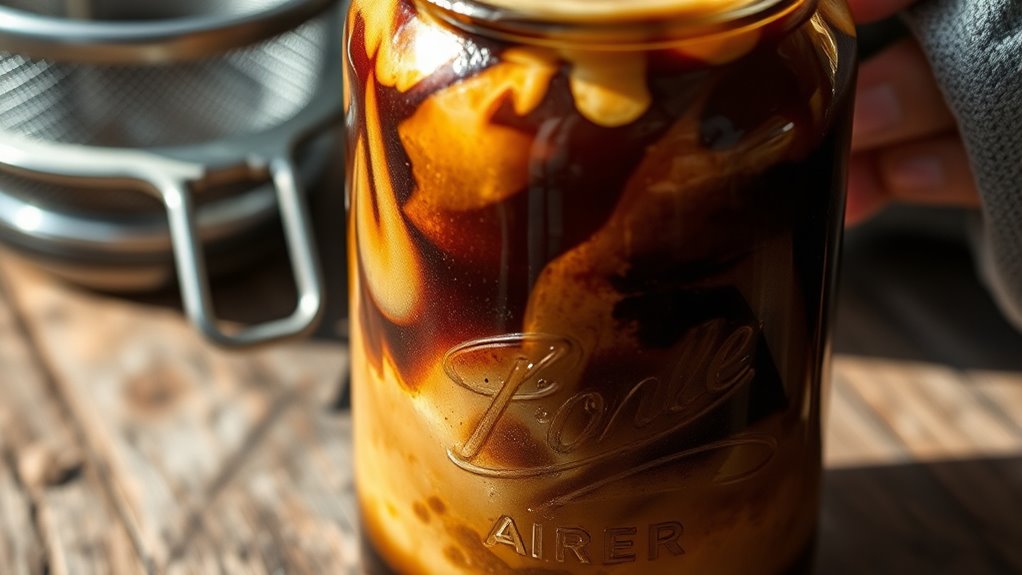
While filtering your cold brew helps remove grounds and sediment, over-filtering can strip away essential oils and flavors that give your coffee depth and richness. To avoid this, focus on what you include during brewing.
Over-filtering cold brew can remove vital oils and flavors, so focus on proper brewing choices.
- Choose high-quality coffee bean selection for a balanced flavor profile.
- Use the right cold brew accessories, like fine mesh filters, to prevent over-filtering.
- Limit filtering to remove only unwanted particles, preserving oils and aroma.
- Experiment with different filter types to find the balance that maintains flavor without sediment.
Drinking Cold Brew Straight From the Fridge

Drinking cold brew straight from the fridge can mute some of its vibrant flavors, so you might notice a slight loss in brightness. Plus, pouring icy cold coffee directly into your mouth could cause temperature shock, making it less enjoyable. To get the best taste and comfort, consider warming it slightly or letting it sit at room temperature for a few minutes.
Flavor Loss Concern
Cold brew can sometimes taste flat or dull if you drink it straight from the fridge because cold temperatures can mute some of its vibrant flavors, including cold brew acidity. To preserve its flavor, consider these tips:
- Warm it slightly before drinking to enhance acidity and flavor complexity.
- Store your cold brew in an airtight container to prevent flavor loss.
- Add a splash of milk or a sweetener to boost flavor perception.
- Avoid leaving it in the fridge for too long, as prolonged storage can diminish freshness.
Temperature Shock Risk
Taking a sip of cold brew straight from the fridge can cause your taste buds to experience a sudden temperature shock, which dulls its flavors and can be unpleasant. This temperature fluctuation occurs because the cold brew’s brewing temperature was optimized for extraction but isn’t meant to be consumed directly from a cold environment. Drinking it at fridge temperature can also mask subtle notes and reduce overall flavor complexity. To avoid this, let your cold brew sit at room temperature for a few minutes before drinking. Gradually warming it up stabilizes the drinking temperature, preserving the delicate flavors. Keep in mind that sudden shifts in temperature can affect your sensory experience, so tempering your cold brew enhances both taste and enjoyment.
Forgetting to Clean Your Equipment Regularly
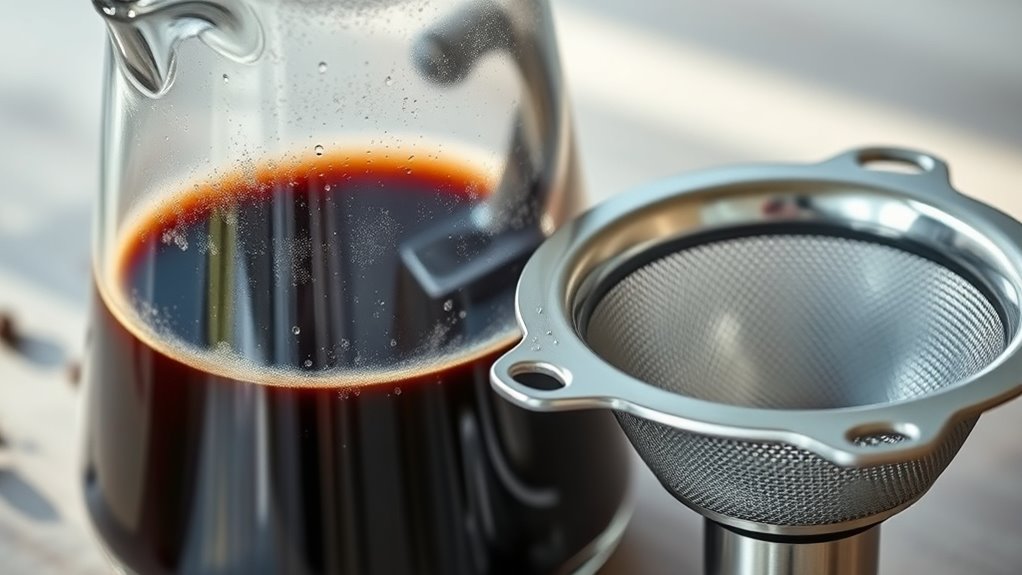
Neglecting to clean your cold brew equipment regularly can lead to stubborn residue buildup and mold growth that compromise both flavor and safety. To guarantee proper equipment maintenance, stick to a consistent brewing schedule that includes cleaning. Here’s what you should do:
- Rinse all parts immediately after brewing to prevent residue from drying.
- Use warm, soapy water to thoroughly clean filters and carafes at least once a week.
- Deep clean with vinegar or a specialized cleaner monthly to remove mineral deposits.
- Dry all components completely before storing to inhibit mold growth.
Following these steps keeps your equipment in top shape, preserves the fresh taste of your cold brew, and minimizes health risks. Regular cleaning is essential for safe, delicious coffee.
Frequently Asked Questions
Can I Make Cold Brew With Instant Coffee?
Yes, you can make cold brew with instant coffee. Just add a few teaspoons of instant coffee to cold water, stir well, and let it steep for about 12-24 hours in the fridge. For better flavor, use brewing tips like adjusting the coffee-to-water ratio and letting it steep longer. This method is quick and convenient, giving you a smooth, invigorating cold brew without the need for grinding beans.
How Long Can I Store Cold Brew Safely?
Think of your cold brew as a delicate flower that needs proper care. You can store it safely in the fridge for up to two weeks, but for the best flavor and spoilage prevention, aim to consume it within seven to ten days. Always keep it in an airtight container, and avoid leaving it out at room temperature. Proper storage duration guarantees your cold brew stays fresh and enjoyable longer.
Is It Okay to Add Milk or Creamer During Brewing?
It’s best to add milk or creamer after brewing your cold brew, not during. Milk addition during brewing can alter the flavor and texture, potentially curdling or spoiling faster. Instead, wait until your cold brew is ready, then add creamer or milk to taste. This preserves the flavor integrity and ensures your cold brew stays fresh longer. Timing your creamer addition is key for a smooth, enjoyable coffee experience.
What’s the Best Container for Cold Brew Storage?
You should store your cold brew in a glass container, as it’s best for coffee preservation and won’t absorb flavors like plastic might. If you prefer, a stainless steel container also works well, keeping your brew fresh without affecting taste. Avoid clear or plastic bottles that can degrade over time or let light in, which can harm flavor. Using the right container guarantees your cold brew stays fresh and flavorful longer.
Can I Reuse Coffee Grounds for Multiple Cold Brew Batches?
Yes, you can reuse coffee grounds for multiple cold brew batches, but it may influence your cold brew efficiency. Reusing grounds can lead to a weaker flavor and less caffeine extraction. To get the best results, use fresh grounds for each batch or limit reuse to one or two times. This ensures you enjoy a rich, flavorful cold brew without sacrificing quality or strength.
Conclusion
Remember, small mistakes like rushing or skipping steps can ruin your cold brew experience. But it’s funny how the simplest habits—like cleaning your gear or using filtered water—can make all the difference. Sometimes, the best cold brew surprises come from paying attention to what you do daily. So, next time you make your brew, keep these tips in mind. After all, perfection often comes from the little things we forget to do.
